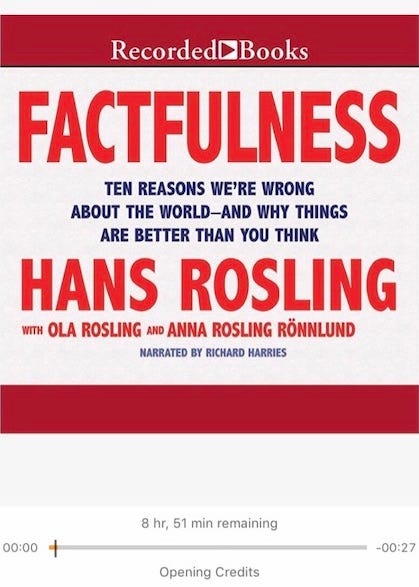Factfulness by Hans Rosling

I like to be aware. I want to know what’s going on, why, and what will change in the future. More than anything though, I love data and I love data that backs up data that shows the true picture. Especially living in the United States, it is way too easy to feel as if everywhere else in the world is far far away, which simply is not true. We can have an impact on anywhere in the world if we want to.
I think that this is extremely valuable for people to remember. Opinions are just that — opinions. Facts matter though, you cannot argue the facts, you can argue the source of the facts but if your sources are reputable, that should be enough to show someone they are suffering from a misconception, as long as you phrase it well.
If you want to convince someone they are suffering from a misconception, it is very useful to test their opinions against the data.
This is a misconception that many have. The gap has closed, and now, the author explained that the world should no longer be viewed in terms of developing and developed countries. Bill Gates wrote about this book in April of 2018 also (linked here). Instead, the authors explained that countries should be viewed in 1 of 4 levels, with most countries at level 2 at the time of publishing.
There is no gap between low and high-income countries.
Talk about tremendous improvement. This is billions of people moving out of extreme poverty.
In 1997, 29% of the world population lived in extreme poverty.
In 2017, only 9% of the world population lived in extreme poverty.
I love how important this statement is. Averages are important sometimes but they are misleading. The Bill and Melinda Gates Foundation, for example, determined that they would give money to private schools because they were shown to have the best schools. However, they were also shown to have the worst schools.
Averages disguise spreads.

When thinking about the current news events, this is what the authors suggested that we do.
Ask yourself, “If there had been an equally large positive improvement, would I have heard about that?”
This is super important to think about, there are always other factors to consider, nothing is just as it appears, there is more beneath the surface.
Straight like instinct is the false idea that the world population is “just” increasing.
People are frightened by various things but there is often no need to feel as though you are truly in danger. Many things that are covered on the news (listed below) as explained by the author, are really rare occurrences.
Fright vs danger
Terrifying events:
Natural disasters — 0.1% of all deaths
Plane crashes — 0.001% of all deaths
Murders — 0.7% of all deaths
Nuclear leaks — 0% of all deaths
Terrorism — 0.05% of all deaths
Frightening — something with a perceived risk
Dangerous — something posing a real risk
I loved the data explained here. Often, as the authors explained, they believed that building hospitals would solve the issue. However, if there is not a level of educating and habit building done, then nothing will change in the long run. If people cannot read directions on medicine, they might not know if they are taking the right amount.
The data shows that half the increase in child survival in the world is because mothers can read and write.
More children are surviving because they don’t get ill in the first place.
Parents wash their hands and mothers can read the instructions on the jar of pills.
Investing money to improve health on levels 1 or 2 should go to primary schools, nurse education, and vaccinations.
Again, this is data that most people might not be aware of. For anyone wondering, Somalia and Afghanistan have the highest infant mortality rates near 10%. While in the US, the infant mortality rate is 5.8 per 1,000, which is higher than the neighboring countries Canada and Cuba. The lowest infant mortality rates are present in Japan and Monaco where the infant mortality is less than 2 per 1,000 (linked here).
In 1950, 97 million children were born and 14.4 million children died — infant mortality rate, 15%.
In 2016, 141 million children born and 4.2 million children died — infant mortality rate, 3%.
People, especially in this age, are accustomed to quick information and also quick changes.
Factfulness is recognizing that many things including people, countries, religions, and cultures appear to be constant just because the change is happening slowly.
Even slow changes add up to create a big change.
To control the destiny instinct, remember that some change is still change.
The next thing that we need to do is to embrace the gray areas. People view things differently and think about various things. Along with that, there are different points of view that people have but also different data points that people address. Complexity is what is valuable.

Be open to ideas from other fields.
The world cannot be understood without numbers and the world cannot be understood with numbers alone.
Beware of simplicity and welcome complexity. Combine ideas. Compromise and solve problems on a case by case basis.
We are not always in control but we all try to be in control. The thing is, there are billions of people in the world all trying to control their own lives, but with billions of people acting independently, that’s impossible. Then add in God and His purpose for our lives, and we really do not have as much control as we wish we did.
We like to believe that things happen because someone wanted them to. That people have power and agency. Otherwise, the world seems confusing and scary.
It’s always more complicated, I love that. It’s all about causes and I LOVE that. These were the final thoughts that I highlighted in the book and thought were important.
Resist blaming any one individual or group of individuals because the problem is when we blame the bad guy, we are done thinking. It’s almost always more complicated than that, about a system.
Faithfulness is recognizing when a scapegoat is being used and remembering that blaming an individual steals focus from other possible explanations and blocks our ability to prevent similar problems in the future.
Look for causes, not villains, accept that bad things can happen without anyone intending them to happen.

This book expanded my horizons and I loved it. I love love loved all the numbers that went beyond all the facts and showed rather than just told us. As I continue to move forward I will embrace my natural curiosity and ask questions. When I hear something new or unknown to me, I won’t simply close my mind, I will ask for further details. When I hear something new, I will act as if what the other person is saying is the total truth and only once I understand their perspective, dissect it further and determine along with them what could be improved or what is missing, as the book said, it’s almost always more complicated than we think.
I gave this book a 4.5/5